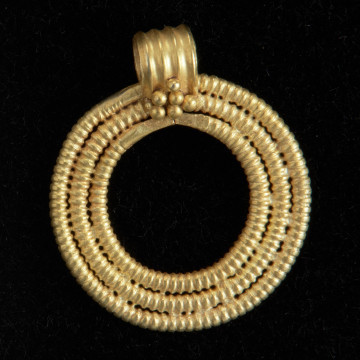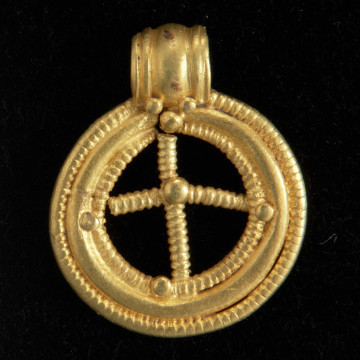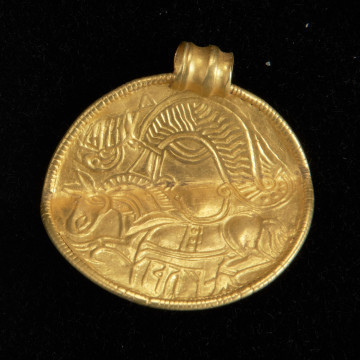
Ring pendant
National Museum in Szczecin
Part of the collection: Antiquity
The gold ring-shaped pendant is made of three rings of beaded wire. It has an eyelet made of the gold plate with five ribs made in repoussé technique. This metalworking technique involves decorating the items made of sheet metal, including gold, by hammering the design on the back side of an ornament to make it convex on the front. On one side at the base of the eyelet there is an asymmetrical group of six gold balls. Such types of pendants are found mainly in southern Scandinavia. The closest specimen to the pendant from Suchań (and another similar one found at the same site) is the one from Ökne in Sweden. Similar specimens from Mausing Mark on Jutland, Høvlsbakke on Zealand and Vasegård on Bornholm can also be mentioned here. In Poland pendants of this design, slightly different from those from Suchań, were discovered in Kujawy. Gold pendants made of beaded wire, empty inside, are also found in Western Europe, including Thuringia and the Alaman territories. These objects are generally dated to the years 450-540, with the youngest specimens occurring in the Merovingian period (6th to 7th centuries). They are known from western France, south-eastern England, the Netherlands, and eastern Germany. The pendant from Suchań, next to another nearly identical specimen, was part of a deposit of gold objects discovered in 2006 and 2007.
Bartłomiej Rogalski
Author / creator
Dimensions
cały obiekt:
Object type
pendicle, pendant
Technique
forming; punching
Material
gold
Creation / finding place
Owner
Muzeum Narodowe w Szczecinie
Identification number
Location / status

National Museum in Szczecin

National Museum in Szczecin

National Museum in Szczecin
DISCOVER this TOPIC
Museum of King Jan III's Palace at Wilanów
DISCOVER this PATH
Educational path